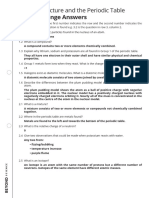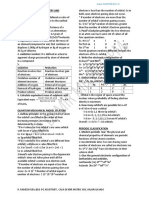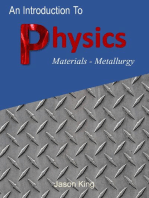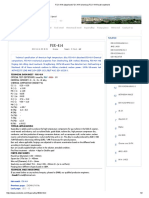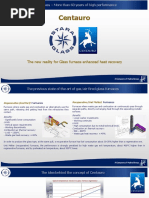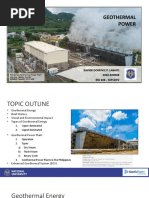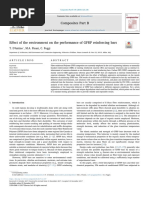1) Explain The Diffusion of Bromine Particles Throughout The Two Gas Jar
1) Explain The Diffusion of Bromine Particles Throughout The Two Gas Jar
Uploaded by
Lee Li JieCopyright:
Available Formats
1) Explain The Diffusion of Bromine Particles Throughout The Two Gas Jar
1) Explain The Diffusion of Bromine Particles Throughout The Two Gas Jar
Uploaded by
Lee Li JieOriginal Title
Copyright
Available Formats
Share this document
Did you find this document useful?
Is this content inappropriate?
Copyright:
Available Formats
1) Explain The Diffusion of Bromine Particles Throughout The Two Gas Jar
1) Explain The Diffusion of Bromine Particles Throughout The Two Gas Jar
Uploaded by
Lee Li JieCopyright:
Available Formats
1
COHORT 2020 SPM PECUTAN KIMIA BERFOKUS - CHEMISTRY TIPS
Form 4 Chapter 2 & 3 (Structure of Atom -Essay?) & (Empirical Formula !!)
[SPM 2017 Chap 2 (Structure P2) : Two isotopes of carbon atoms + sketch graph temp against time + explain why
temperature remains constant for heating curve]
a) able to define Nucleon number : Total number of proton and neutron in the nucleus of an atom. [Reject : Proton
number]
b) able to define Valence electron : Electron in the outermost shell of an atom [Reject : Element]
c) able to define isotope : Atoms of same element with same number of proton but different number of neutron.
d) able to define empirical formula : Empirical formula is the chemical formula that shows the simplest ratio of the
number of atom of each element in a compound
e) able to define molecular formula : Molecular formula is the chemical formula that shows the actual number of
atom of each element in a compound / molecule.
1)Explain the diffusion of bromine particles throughout the two gas jar.
- Bromine gas consist of tiny and discrete particles.
- When cover is removed, the bromine molecules move randomly from higher concentration region to lower
concentration region
2) Draw atomic structure (Show three subatomic particles) and describe the atomic structure.
• The atom consists of two parts : centre part called nucleus and
outer part called electron shells.
• The nucleus of sodium atom consists of 11 protons which is
positively charged and 12 neutrons which is neutral.
• There are 11 electrons in the shells which is negatively charged.
• The electrons are moving in orbits.
3)
Organic substance Z is in solid state at room temperature. When it placed under
sunlight, solid Z melts into liquid at certain temperature.
Describe a laboratory experiment to determine the melting point of solid Z by using organic substance
Z powder. [9 marks / 10 marks]
Prepared by : Mr. Patrick Chai, SMK Rosli Dhoby, Sibu
2
2 .Master all the calculation from chapter 3 and chapter 7
Concentration in gdm-3 Concentration in mol dm-3 (molarity)
mass of solute (g) Number of moles of solute (mol)
volume of solution (dm3) ÷ 1000 volume of solution (dm3)
3
* if volume in cm3 , must convert to dm3 first (cm →
dm3)
Conversion of units of concentration Number of moles , ( liquid )
÷ Molar mass Number of moles = MV
Concentration Molarity M = molarity ( mol dm-3 )
(g dm-3 ) × Molar mass (mol dm-3 ) V = Volume of solution ( dm3)
Neutralisation reaction Dilution method
( acid + alkali → salt and water )
MaVa = a
MbVb b
Stoichiometric calculation
Step 1:
Convert a given quantity (mass / volume ; given molarity& volume) into number of moles.
Step 2:
Write a balanced equation
Step 3:
Based on the mole ratio, determine the number of moles of the unknown quantity.
Step 4:
Convert the calculated number of moles into required quantity ( mass ; volume; molarity ).
Test Yourself :
1. 4 g of copper(II) oxide reacts with excess dilute hydrochloric acid. Calculate the mass of copper(II) chloride
produced.
[RAM : O=16, Cu=64, Cl=35.5]
2. 50 cm3 of 2 mol dm-3 hydrochloric acid reacted with excess zinc powder. Calculate the volume of hydrogen gas
released under room conditions.
[Molar volume = 24 dm3 mol-1]
Prepared by : Mr. Patrick Chai, SMK Rosli Dhoby, Sibu
3
3. Describe an experiment to determine empirical formula of magnesium oxide – Not in Essay section before!
Prepared by : Mr. Patrick Chai, SMK Rosli Dhoby, Sibu
4
1) Students able to suggest one metal and one acid to produce hydrogen gas and able to write a balanced chemical
equation for the reaction.
2) Students able to explain why hydrogen gas is flow continuously before starting the heating process.
3) Students able to explain why hydrogen gas is allowed to flow when product of heating is cooled.
4) Students able to explain how ensure the reaction of oxide of copper is completely reduced to copper.
5) Students able to describe a test to determine the combustion tube is full filled with hydrogen gas.
6) Students able to determine the empirical formula of oxide of copper.
Prepared by : Mr. Patrick Chai, SMK Rosli Dhoby, Sibu
5
Form 4 Chapter 4 & Chapter 5 in Structure and Essay!!
[2019 chapter 4 Structure: Group 1 element and include also reaction with oxide of group 1 with water]
[2019 chapter 5 Structure: ionic compound MgO and Covalent compound CO2]
[2019 chapter 5 P3 planning : Experiment electrical conductivity for ionic compound and covalent compound]
(*Chapter 4 Long time not set in essay part since 2006)
1. In this chapter, Remember to put the word of *ATOM* OR *MOLECULE* for the explanation
Eg : Sodium atom has a higher tendency to donate its valence electron // The Van der Waals
forces of attraction between molecules become stronger.
Practice all the balanced chemical equations for all the reactions in group 1 and group17
Group 1 + water Group 17 + water
2Na + 2H2O → 2 NaOH + H2 Cl2 + H2O → HCl + HOCl
Group 1 + oxygen Group 17 + NaOH
4Li + O2 → 2Li2O Cl2 + 2NaOH → NaCl + NaOCl + H2O
Group 1 + halogen Group 17 + iron
2K + 2Cl2 → 2 KCl 3Cl2 + 2Fe → 2 FeCl3
Period 3 Na2O + H2O → 2NaOH
Must able to explain the difference reactivity of elements when going down the group 1 and 17
COMPARE THE REACTIVITY OF SODIUM AND POTASSIUM
• Atomic size of potassium atom is bigger than sodium atom // Distance between nucleus and
valence electron of potassium atom is further than sodium atom
• The forces of attraction between nucleus and valence electron of potassium atom is weaker than
sodium atom
• Potassium atom is easier to release its valence electron than sodium atom
• Hence potassium atom is more reactive than sodium atom
COMPARE THE REACTIVITY OF CHLORINE AND BROMINE
• Atomic size of chlorine atom is smaller than bromine atom // Distance between nucleus and
valence electron of chlorine atom is nearer than bromine atom
• The force of attraction / strength of nucleus to attract electron into its outermost shell of
chlorine atom is stronger than bromine atom
• Hence ,Chlorine atom is more reactive than Bromine atom
Must able to explain the why the atomic size of Cl is smaller than Na
• Number of proton in the nucleus of Cl atom is bigger than that of Na atom [ Reject : Proton
number]
• The force of attraction of nucleus on valence electron of chlorine atom is stronger than bromine
atom
• Hence , the shells occupied with electrons in Cl atom are pulled closer to the nucleus
Must able to explain why the electronegativity increases across the period from left to right
• Atomic size decreases
• The forces of attraction between nucleus and its valence electron becomes stronger
• Atom easier to accept electron
Prepared by : Mr. Patrick Chai, SMK Rosli Dhoby, Sibu
6
Form 4 chapter 5 (Chemical Bonds) in Essay!!
a) Able to explain and draw the electron arrangement of ionic compound and covalent compound correctly
Explain the formation of ionic bond and covalent bond + draw the electron arrangement
FORMATION OF MAGNESIUM CHLORIDE FORMATION OF CARBON DIOXIDE
Pt1: The electron arrangement of Magnesium atom is 2.8.2 Pt1 : Electron arrangement of atom D is 2.4.
Pt2 : The electron arrangement of chlorine atom is 2.8.7 Pt2 : Electron arrangement of atom E is 2.6.
Pt3 : In order to achieve a stable octet electron Pt3 : In order to achieve a stable octet electron arrangement,
arrangement Pt4 : An atom D contribute 4 electrons for sharing
Pt4 : A Magnesium atom donates 2 electrons to form a Pt5 : Each of atom E contribute 2 electrons for sharing
positive ion , Mg2+ . Pt6 : One atom D share two pair of electrons or 4 electrons
Pt5 : Each of chlorine atom receives 1 electron to form with 2 atoms E
negative ion , Cl- . Pt7 : Covalent compound, DE2 is formed.
2+ -
Pt6 : Mg and Cl are attracted together by strong
electrostatic force Pt 8 & Pt 9 :
Pt7 : to form an ionic compound, MgCl2
Pt8 & Pt9 :
Explain the differences of physical property of ionic compound and covalent compoundfrom aspect electrical condu
ctivity and the melting point
Ionic compound ions Covalent compound -molecules
HIGH MELTING AND BOILING POINT LOW MELTING AND BOILING POINT
-The ions are attracted together by strong electrostatic -The molecules are attracted together by weak Van Der
force Waals force
-More heat energy is required to overcome the forces of -Less heat energy is required to overcome the forces of
attraction between the ions attraction between the molecules
CAN CONDUCT ELECTRICITY IN MOLTEN OR CANNOT CONDUCT ELECTRICITY IN ANY STATE
AQUEOUS STATE - consists only neutral molecules
-the ions can move freely - No freely moving ions are present
Examples of Open Response Essay
Compounds M and N are two white solids at room temperature. A small amount of of solids M and N are added
separately to 5 cm3 of distilled water in two different test tubes and shaken well. The results obtained are shown
in Table 9.
Compound M N
Observation The white solid remains The white solid N dissolves
unchanged in the water. and a colourless solution is
formed.
Table 9
The student carried out another experiment to study the electrical conductivity of compounds M and N in the
solid and molten states.
By using a suitable examples of compound M and compound N, describe an experiment how you can differentiate
compound M and compound N based on their electrical conductivity in the solid and molten states.
[10 marks]
Prepared by : Mr. Patrick Chai, SMK Rosli Dhoby, Sibu
7
Prepared by : Mr. Patrick Chai, SMK Rosli Dhoby, Sibu
8
Form 4 chapter 6 (Electrolysis) in Structure and PAPER 3!!
[2019 : Essay section C - Electrolysis Factor concentration of ion and type of electrode + Describe experiment to
determine the positions of metal A, metal B dan metal C in electrochemical series (Displacement metal)]
a) Able to define Electrolysis : Process whereby compounds in molten or aqueous state / electrolyte are broken
down into their elements by passing electricity through it.
Able to Master all the three Factors:
1) Position of Ions in the Electrochemical Series
Electrolysis of copper(II) sulphate solution by using carbon electrodes:
ANODE CATHODE
List all the ions present in the
solution
Which ion moves to the anode and
cathode
Name the ion that selected to be
discharged
Reason
Half equation
Observation
Confirmatory test of the product
Electrolysis of copper(II) sulphate solution by using copper electrodes:
ANODE CATHODE
List all the ions present in the
solution
Which ion moves to the anode and
cathode
Name the ion that selected to be
discharged
Reason
Half equation
Observation
Confirmatory test of the product
Prepared by : Mr. Patrick Chai, SMK Rosli Dhoby, Sibu
9
Electrolysis of 1.0 mol dm-3 potassium iodide solution by using carbon electrodes:
Please take note if very dilute 0.0001 mol dm-3 potassium iodide solution is electrolysed, factor of position of
ion will take part.
ANODE CATHODE
List all the ions present in the
solution
Which ion moves to the anode and
cathode
Name the ion that selected to be
discharged
Reason
Half equation
Observation
Confirmatory test of the product
Able to compare and contrast chemical cell and electrolytic cell (essay part)
(b) Diagram 8.2 shows two types of cell.
Copper Zinc
Copper Zink
Kuprum Kuprum
Diagram 8.2
Compare and contrast cell A and cell B in terms of:
• Type of cell
• The energy change
• Ions presence in the electrolyte
• The anode and cathode of the cells
• Half equations for both electrodes
• Observation at the anode of each cell - [10 marks/markah]
Prepared by : Mr. Patrick Chai, SMK Rosli Dhoby, Sibu
10
Cell A Cell B
Sel A Sel B
Type of cell Electrolytic cell Voltaic cell / Chemical cel
Energy change Electrical energy to chemical energy Chemical energy to electrical energy
Ions presence in
the electrolyte Cu2+, H+, SO42-and OH-
Half equation Anode: Anode:
Cu → Cu2+ + 2e- Zn → Zn2+ + 2e-
Cathode: Cathode:
Cu2+ + 2e- → Cu Cu2+ + 2e- → Cu
Observation Anode: Anode:
The copper electrode becomes The zinc electrode becomes thinner
thinner
Cathode: Cathode:
Brown solid is deposited / Copper Brown solid is deposited / Copper
electrode becomes thicker electrode becomes thicker
Form 4 Chapter 7 (Acid and Bases – Paper 3 & Form 4 Chapter 8 (SALTS – Essay / Structure)
[2019 : Structure : Describe briefly preparation of stock solution by dilution method + Titration method +
Calculation]
[2019 : Essay Section C : Chemical test to verify anion chloride ion and sulphate ion + Double decomposition
reaction + Describe experiment to prepare NaCl in the school laboratory.
a) Able to explain the differences physical properties of acid in water solvent and methylbenzene
solvent (Must have pairing)
In water solvent In methylbenzene solvent
Hydrogen chloride ionizes in water to produce H+ Hydrogen chloride cannot ionizes in methylbenzene
The present of hydrogen ions responsible for the No hydrogen ion is present. Therefore, hydrogen
acidic properties / change the colour of blue litmus chloride in methylbenzene cannot show acidic
paper to red properties / does not change the colour of blue
litmus paper
Hydrochloric acid produces high concentration of H + Ethanoic acid produces low concentration of H+
The higher the concentration of H , the lower the pH
+ The lower the concentration of H+, the higher the pH
value value
b) Able to explain different pH value between strong acid and weak acid (Must have pairing)
Strong Acid Weak acid
Example : Hydrochloric acid / Nitric acid / Sulphuric Example : Ethanoic acid
acid
Hydrochloric acid ionizes completely in water to Ethanoic acid ionizes partially in water to produce H+
produce H +
Hydrochloric acid produces high concentration of H+ Ethanoic acid produces low concentration of H+
The higher the concentration of H+, the lower the pH The lower the concentration of H+, the higher the pH
value value
Prepared by : Mr. Patrick Chai, SMK Rosli Dhoby, Sibu
11
c) able to define the meaning of salt-
Salt is an ionic compound formed when hydrogen ion from an acid is replaced by metal ion or the ammonium
ion.
d) Able to describe a chemical test to identify all the anion (CO32-, Cl-, SO42-, and NO3-)
(Use RODA IMPIAN To memorize all the chemical reagents)
[Notes : The green tick √ shows chemical reagents used must be correct. If not able to give correct
reagents, then the mark for observation and conclusion automatically will not be awarded]
Describe chemical test to verify chloride ion Describe chemical test to verify sulphate ion
1. Add 2cm3 of salt solution into a test tube. 1. Add 2cm3 of salt solution into a test tube.
2. Add __________ acid into the test tube. √ 2. Add __________ acid into the test tube. √
3. Add ____________________ solution into the test tube.√ 3. Add ____________________ solution into the test tube.√
4. Observation : ______________________________ is formed. 4. Observation : ______________________________ is formed.
5. Conclusion : Cl- ion is present. 5. Conclusion : SO42- ion is present.
Describe chemical test to verify nitrate ion
1. Add 2cm3 of salt solution into a test tube.
2. Add dilute _________________ acid into the test tube. √
3. Add ____________________ solution into the test tube.√
4. Slant the test tube. Add few drops concentrated _______________________ acid slowly down the wall of the
test tube. √
5. Observation : ______________________________ is formed.
6. Conclusion : NO3- ion is present.
Prepared by : Mr. Patrick Chai, SMK Rosli Dhoby, Sibu
12
e) Able to describe a chemical test to identify Pb2+ / NH4+ / Fe2+ / Fe3+
[Reject : NaOH solution / NH3 solution / NaCl solution / Na2SO4 solution to confirm Pb2+]
Describe chemical test to verify Iron(II) ion Describe chemical test to verify Iron(III) ion
1. Add 2cm3 of salt solution into a test tube. 1. Add 2cm3 of salt solution into a test tube.
2. Add ___________________________________________ solution 2. Add ___________________________________________ solution
into the test tube.√ into the test tube.√
4. Observation : ______________________________ is formed. 3. Observation : ______________________________ is formed.
5. Conclusion : Fe2+ ion is present. 4. Conclusion : Fe3+ ion is present.
Describe chemical test to verify lead(II) ion
1. Add 2cm3 of salt solution into a test tube.
2. Add ____________________ solution into the test tube. √
3. Observation : ______________________________ is formed.
4. Conclusion : Pb2+ ion is present.
Describe chemical test to verify ammonium ion
1. Add 2cm3 of salt solution into a test tube.
2. Add ____________________ reagent into the test tube. √
3. Observation : ______________________________ is formed.
4. Conclusion : NH4+ ion is present.
Example Salt Essay open Response (Come out once in SPM 2013) Aras Tinggi
The table shows three substances used to prepare magnesium sulphate.
Sulphuric acid, Magnesium nitrate, Carbonate Salt
By using substances from the table, describe how to prepare magnesium sulphate salt in the laboratory. Include
the chemical equations involved in your description. [10 marks]
1. Student must able to name the carbonate salt : Potassium carbonate / Sodium carbonate and ammonium
carbonate.
2. Measure and Pour _______ cm3 of _______ mol dm-3 ___________________________ solution into a beaker.
3. Measure and Pour _______ cm3 of _______ mol dm-3 ___________________________ solution into the beaker containing
_____________________________ solution.
Do double
4. Filter and _______________ the salt at the residue.
decomposition reaction
5. Measure and Pour _______ cm3 of _______ mol dm-3 ___________________________ solution into a beaker. Heat the
acid.
Add excess metal
6. Add __________________________ until excess into the acid.
carbonate into hot acid
7. Filter the excess _______________________________ .
8. Pour the filtrate into an evaporating dish and heat the filtrate until _______________________ .
9. __________ the saturated solution until salt crystals formed and ____________ the content of the evaporating dish.
10. Balanced chemical equation :
______________________________________________________________________________________________________________________
11. Balanced chemical equation :
______________________________________________________________________________________________________________________
Prepared by : Mr. Patrick Chai, SMK Rosli Dhoby, Sibu
13
Form 4 Chapter 9 (Manufactured Substances In Industry)
[2019 : Structure: Haber Process and Contact process → Fertilizer X
]
Hardness of Alloy experiment – essay part
Pure copper is soft. When copper is alloyed, it becomes harder and stronger.
Name one example of alloy of copper.
Describe an experiment to show that alloy of copper is harder than pure copper.
In your description, include a labelled diagram for the apparatus set-up for this experiment. [10 marks]
Pt 1 : Able to give an example of alloy of copper ; Bronze / Brass
Pt2 & 3 : Able to draw a labelled diagram for the set-up of apparatus
Pt4 - pt 8 : Able to describe the procedures of conducting the experiment
Pt 9 : Tabulation of data
Pt10 : Interpreting of data
Pt11 : Conclusion
Contact process or Haber process – structure / essay
Contact Process
a) Able to describe the reaction occurs in each stage in contact process
b) Able to state conditions required in stage 2 to produce higher percentage of sulphur trioxide gas
c) Able to write a balanced chemical equation for each stage.
d) Able to explain why sulphur trioxide gas are not directly dissolves in water to form sulphuric acid.
Haber Process
a) Able to state conditions required to produce higher percentage of ammonia
b) Able to write a balanced chemical equation for the reaction occured in Haber Process
Ammonium Sulphate is the product formed by Contact Process and Haber Process.
a) Able to state the use of ammonium sulphate
b) Able to calculate the percentage of nitrogen by mass of given fertilizers and able to choose the best fertilizer.
Alloy + Glass + Ceramic + Polymer + Composite materials - structure / essay
a) Able to explain the difference in the hardness of pure copper and bronze
Pure copper Bronze
Copper atoms are of the same size Copper atoms and tin atoms are of different
sizes
Atoms are arranged orderly The presence of tin atoms disturb the orderly
arrangement of atoms in the pure copper atoms
[a : not arranged in orderly]
Layers of atoms are easily slide on one another Reduces the layer of atoms from sliding one
another
Conclusion : Bronze is stronger and harder than its pure copper
* Must in pairing
b) Able to state the specific properties of the use of alloy/glass/ polymers/composite materials
Prepared by : Mr. Patrick Chai, SMK Rosli Dhoby, Sibu
14
PAPER 3 PLANNING EXPERIMENT FORM4
Form 4
1. To study the acid and base properties of aluminium oxide, sodium oxide and phosphorus pentoxide
2. To study the factor of position ions/concentration ions/type of electrode on the products of electrolysis //
Electroplating of metal
Problem statement How does the acid-base properties of the oxides of elements change across Period
3?
Hypothesis When across Period 3 from left to right, the oxide of elements change from basic to
amphoteric to acidic //
Magnesium oxide soluble in acid, aluminium oxide soluble in both acid and alkali
and phosphorus pentoxide soluble in an alkali
Variables Manipulated : Types of oxide
Responding : Solubility of oxide in acid or alkali // The oxide property
Fixed : Nitric acid and sodium hydroxide solution
Materials and Apparatus Materials : Magnesium oxide, Aluminium oxide and Phosphorus pentoxide
Apparatus : Test tubes. Test tube rack, Bunsen Burner, Test tube holder, spatula and
glass rod.
Procedure 1. Add 5 cm3 of 2 mol dm-3 nitric acid and 5 cm 3 of 2 mol dm-3 sodium
hydroxide solution in two separate test tubes.
2. Using a spatula, put magnesium oxide into each of the test tubes.
3. Heat both test tubes gently.
4. Stir it with a glass rod until no further change.
5. Observe and record the solubility of the oxide in nitric acid and sodium
hydroxide.
6. Repeat steps 1 to 5 using aluminium oxide and phosphorus pentoxide
respectively to replace magnesium oxide.
Tabulation of data
Oxide of elements Solubility
in nitric acid in sodium hydroxide
solution
Magnesium oxide
Aluminium oxide
Phosphorus pentoxide
Prepared by : Mr. Patrick Chai, SMK Rosli Dhoby, Sibu
15
Electrolysis of copper(II) sulphate by using copper electrodes and carbon electrodes
Problem statement : How do the types of electrodes affect the products of
electrolysis of copper (II) sulphate solution?
Hypothesis : When copper electrodes are used instead of carbon electrodes, types of
products formed at the anode are different.
Manipulated variable: Different types of electrodes.
Responding variable : Products formed at the anode // Mass of anode
Fixed variable : Concentration of aqueous copper(II) suphate solution//Type of electrolyte
Apparatus : Beaker, carbon electrodes, copper electrodes, ammeter, connecting wires
with crocodile clips, sandpaper, electronic balance and batteries
Materials : Aqueous copper(II) sulphate 1 mol dm-3
Procedure :
1. Clean the carbon electrode using sand paper.
2. Weigh carbon electrode serve as anode using electronic balance and record the readings.
3. Pour 1 mol dm-3 copper (II) sulphate solution into a beaker until half full.
4. Connect carbon electrodes to the batteries and ammeter using connecting wires.
5. Dip the both electrodes into copper(II) sulphate solution.
6. Complete the circuit and allow current flow for about 20 minutes.
7. After 20 minutes, remove the anode, rinse with distilled water and dry it. Then weigh again.
8. Repeat steps 1 to 7 by using with copper electrodes to replace the carbon electrodes.
Observation :
Type of electrodes Mass of the anode (g)
Before After
Carbon
Copper
Prepared by : Mr. Patrick Chai, SMK Rosli Dhoby, Sibu
16
Investigate the factor of concentration of ions on the selective discharge of ions at the
electrodes
Problem statement : How does the concentration of ions in hydrochloric acid affect the discharge
of ions at the anode?
Hypothesis : When the concentration of chloride ion is higher, the chloride ion will be
selectively discharged at the anode.
Manipulated variable: Concentration of chloride ion
Responding variable : Products of electrolysis at the anode//Types of Ions discharged at the anode.
Fixed variable : Type of electrode//Type of electrolyte
Apparatus : Electrolytic cells, carbon electrodes, ammeter, connecting wires with crocodile
clips, batteries and wooden splinter
Materials : 1.0 mol dm-3 hydrochloric acid, 0.001 mol dm-3 hydrochloric acid, blue and
red litmus paper
Procedure :
1. Fill the electrolytic cell with 1.0 mol dm-3 hydrochloric acid until its level is above the electrode .
2. Fill two test tubes with 1.0 mol dm-3 hydrochloric acid until full and invert it over the each carbon
electrodes
3. Connect the electrodes to the batteries and ammeter using connecting wires.
4. Complete the circuit and allow current flow for about 20 minutes.
5. Collect the gas produced at the anode with two test tube.
6. Insert moist blue litmus paper into the first test tube and Insert a glowing wooden splinter into the
second test tube.
7. Record the observation.
8. Repeat steps 1 to 7 by using 0.0001 mol dm-3 hydrochloric acid.
Observation :
Electrolyte Observation at the anode
1.0 mol dm-3 hydrochloric acid
0.0001 mol dm-3 hydrochloric acid
THE END
MAY GOD BLESS YOU
Prepared by : Mr. Patrick Chai, SMK Rosli Dhoby, Sibu
You might also like
- Emerson Refrigeration ManualDocument354 pagesEmerson Refrigeration Manualnewnse2008100% (1)
- K M/2012/G.B.TeeDocument17 pagesK M/2012/G.B.TeeLee Li JieNo ratings yet
- Catalase and Hydrogen Peroxide Experiment: Problem: What Happens When A Potato Is Combined With Hydrogen Peroxide?Document1 pageCatalase and Hydrogen Peroxide Experiment: Problem: What Happens When A Potato Is Combined With Hydrogen Peroxide?Big CinemaNo ratings yet
- Chemistry Tips Focus SPM 2022Document23 pagesChemistry Tips Focus SPM 2022tiffanie lzyNo ratings yet
- Tips Edited by Mr. Chai and Yati 2016 PDFDocument10 pagesTips Edited by Mr. Chai and Yati 2016 PDFsitiNo ratings yet
- CHE1501 2018 S2 Memo Ass4andExamPrepDocument18 pagesCHE1501 2018 S2 Memo Ass4andExamPrepZethu Khah100% (1)
- Last Minute RevisionDocument7 pagesLast Minute Revisionangziyi575No ratings yet
- I PUC Model QP AnswerDocument8 pagesI PUC Model QP AnswerSamanth PattarNo ratings yet
- Science Assessment Year 11Document8 pagesScience Assessment Year 11AdrianNo ratings yet
- Che QP 2018Document14 pagesChe QP 2018Vinay AdariNo ratings yet
- Aqa Chemistry 2 Revision NotesDocument16 pagesAqa Chemistry 2 Revision NotesWaygen ThorNo ratings yet
- Answer Key Sample Paper XIDocument12 pagesAnswer Key Sample Paper XIabhaas.arora.delhiNo ratings yet
- 902B B.P.S. IX S.A. II Science Chapterwise 5 Printable Worksheets With Solution 2014 15Document111 pages902B B.P.S. IX S.A. II Science Chapterwise 5 Printable Worksheets With Solution 2014 15AnujMaurya100% (1)
- Jai Shree RamDocument10 pagesJai Shree RamRenu YadavNo ratings yet
- AQA Atomic Structure and The Periodic Table Revision Game AnswersDocument4 pagesAQA Atomic Structure and The Periodic Table Revision Game AnswersGAIDANo ratings yet
- Chemistry 2014 SolDocument15 pagesChemistry 2014 SolrahulNo ratings yet
- Model Paper 6 SchemeDocument11 pagesModel Paper 6 SchemeKalyan ReddyNo ratings yet
- Chapter 2: Matter: Temperature, CDocument45 pagesChapter 2: Matter: Temperature, CsookchinNo ratings yet
- Task #3 EOC Marking Feedback FinalDocument32 pagesTask #3 EOC Marking Feedback Finalnchavla23No ratings yet
- 2024_12_06_11_12_solutionDocument10 pages2024_12_06_11_12_solutionsuryavanshisatya48No ratings yet
- Nota Ringkas Kimia Form 4 5Document45 pagesNota Ringkas Kimia Form 4 5Nor Syahirah MohamadNo ratings yet
- Key Sem1 Mid 1Document7 pagesKey Sem1 Mid 1c9gqf4bt9wNo ratings yet
- Covalent Bonding NotesDocument39 pagesCovalent Bonding NotesAmaris HopkinsNo ratings yet
- Solución RespuestasRepasoDocument63 pagesSolución RespuestasRepasoCarmen LostalNo ratings yet
- Aqa 74041 QP Mqp18a4 Jun19Document50 pagesAqa 74041 QP Mqp18a4 Jun19Alaa ShnienNo ratings yet
- Modul Focus SPM 2020Document46 pagesModul Focus SPM 2020Thanabalan MunuswamyNo ratings yet
- Atoms and Molecules Class 9 Extra Questions Science Chapter 3Document13 pagesAtoms and Molecules Class 9 Extra Questions Science Chapter 3tarun arora100% (1)
- Chemical Bonding Class XI NotesDocument5 pagesChemical Bonding Class XI NotesSuparna75% (12)
- Yr10 Chemistry Paper 2 YE22Document14 pagesYr10 Chemistry Paper 2 YE22Ern QiNo ratings yet
- Science Class Ix Term 2Document62 pagesScience Class Ix Term 2Jayashree Krishnakumar PillaiNo ratings yet
- Final Examination in CHEMISTRYDocument25 pagesFinal Examination in CHEMISTRYagnelsajicr7No ratings yet
- 3 Periodic Properties of the Element Part 1 Period 3_b812715f3c0fc39c6562a4f1b5dfef2bDocument38 pages3 Periodic Properties of the Element Part 1 Period 3_b812715f3c0fc39c6562a4f1b5dfef2bVinylsenNo ratings yet
- Target SPM P2 2013 1. Structure of Atom/Bonding/Boiling and Melting PointDocument38 pagesTarget SPM P2 2013 1. Structure of Atom/Bonding/Boiling and Melting PointChee Jin TangNo ratings yet
- Karnataka PUC Board (KSEEB) Chemistry Class 12 Question Paper 2017Document14 pagesKarnataka PUC Board (KSEEB) Chemistry Class 12 Question Paper 2017lohith. sNo ratings yet
- JR ImpDocument8 pagesJR ImpGovindu PrathapNo ratings yet
- Extra Solved Questions Class Ix Term II ChemistryDocument3 pagesExtra Solved Questions Class Ix Term II Chemistrychhabra navdeep100% (1)
- STL Yr9 - CETDocument6 pagesSTL Yr9 - CETmyint mohNo ratings yet
- Worksheet - Rev - Year End Review No Gases - AnswersDocument8 pagesWorksheet - Rev - Year End Review No Gases - AnswerskarandeepNo ratings yet
- Midterm Review Packet With QuestionsDocument58 pagesMidterm Review Packet With Questionszoohyun91720No ratings yet
- 749Revision Booklet 1-4 Class 12Document9 pages749Revision Booklet 1-4 Class 12mani7737912No ratings yet
- Chemistry For Engineers Assignment 2: Part I: Multiple Choice Questions (5Pts)Document2 pagesChemistry For Engineers Assignment 2: Part I: Multiple Choice Questions (5Pts)Đạt Trương MinhNo ratings yet
- +1 Chemistry Ultimate Question BankDocument257 pages+1 Chemistry Ultimate Question BankShiraz IllyasNo ratings yet
- Y 12 PeriodicityDocument28 pagesY 12 Periodicityنور هدايو احمدNo ratings yet
- class 11 chem (1) Answer keyDocument4 pagesclass 11 chem (1) Answer keyMUSIC IS LIKE MAGICNo ratings yet
- Basic Chemistry Notes latestDocument73 pagesBasic Chemistry Notes latestGodspower OgbonnayaNo ratings yet
- Chapter No.5 and 6Document22 pagesChapter No.5 and 6hasnainNo ratings yet
- Hsslive Xii Chemistry CH 9 Coordination Compounds by SajeevDocument2 pagesHsslive Xii Chemistry CH 9 Coordination Compounds by SajeevrasalgafoorrvgNo ratings yet
- Chemistry_En_ يلا نذاكرDocument15 pagesChemistry_En_ يلا نذاكرam2361998No ratings yet
- 11th Chemistry Unit 1 Important 2 and 3 Mark Questions With Answer English Medium PDF DownloadDocument18 pages11th Chemistry Unit 1 Important 2 and 3 Mark Questions With Answer English Medium PDF Downloadp.k.sachenNo ratings yet
- Transition MetalDocument45 pagesTransition MetalNurul NadiaNo ratings yet
- Namma Kalvi 11th Chemistry 2 Mark and 3 Mark Notes em 216472Document16 pagesNamma Kalvi 11th Chemistry 2 Mark and 3 Mark Notes em 216472vvn natrajNo ratings yet
- StructureDocument31 pagesStructurenur amirahNo ratings yet
- Chemistry Chemical Bonding Answer Key 06-12-2024!08!54 11Document5 pagesChemistry Chemical Bonding Answer Key 06-12-2024!08!54 11Janvi RajputNo ratings yet
- The Structure of The AtomDocument33 pagesThe Structure of The AtomWilley TaluanNo ratings yet
- Basic Chemistry Techs Presentation formattedDocument88 pagesBasic Chemistry Techs Presentation formattedGodspower OgbonnayaNo ratings yet
- 11 HW ChemistryDocument6 pages11 HW ChemistryJ BalanNo ratings yet
- 普化2Document60 pages普化2zhooongNo ratings yet
- Chemistry 6031/2Document13 pagesChemistry 6031/2mhlongosigidi23No ratings yet
- Assignment 2Document2 pagesAssignment 2Duy Do MinhNo ratings yet
- CH205 Test 1 2021Document6 pagesCH205 Test 1 2021avnishnandNo ratings yet
- 2NDPIVOTLessonOnDistinguisgingIonic Covalent StudesDocument35 pages2NDPIVOTLessonOnDistinguisgingIonic Covalent StudesJohn Angelo QueseaNo ratings yet
- FORM 5 - Chapter 3 - NOTE - Electromagnetism - PART 1 (Wo)Document38 pagesFORM 5 - Chapter 3 - NOTE - Electromagnetism - PART 1 (Wo)Lee Li JieNo ratings yet
- List of Bombastic WordsDocument35 pagesList of Bombastic WordsLee Li Jie100% (2)
- NOTE - Final Revision SPM 2020 (Part 1)Document49 pagesNOTE - Final Revision SPM 2020 (Part 1)Lee Li JieNo ratings yet
- NOTE - Final Revision SPM 2020 (Part 2)Document65 pagesNOTE - Final Revision SPM 2020 (Part 2)Lee Li JieNo ratings yet
- PAPER 3 - SECTION B - PhysicsDocument21 pagesPAPER 3 - SECTION B - PhysicsLee Li JieNo ratings yet
- K M/2011/G.B.TeeDocument14 pagesK M/2011/G.B.TeeLee Li JieNo ratings yet
- Chapter 5 Chemicals For Consumers: 5.1 Soap and Detergent (A) SoapDocument24 pagesChapter 5 Chemicals For Consumers: 5.1 Soap and Detergent (A) SoapLee Li JieNo ratings yet
- Peperiksaan Percubaan SBP Fizik 2011 Marking Scheme For Physics Paper 2Document8 pagesPeperiksaan Percubaan SBP Fizik 2011 Marking Scheme For Physics Paper 2Lee Li JieNo ratings yet
- Application of Radioisotope: Name:Lee Li Qin Kelas: 5 HarapanDocument2 pagesApplication of Radioisotope: Name:Lee Li Qin Kelas: 5 HarapanLee Li JieNo ratings yet
- Chemistry: Name: - Class: - DateDocument9 pagesChemistry: Name: - Class: - DateLee Li JieNo ratings yet
- Poem The Charge of The Light BrigadeDocument6 pagesPoem The Charge of The Light BrigadeLee Li JieNo ratings yet
- The Living PhotographDocument6 pagesThe Living PhotographLee Li JieNo ratings yet
- The Romance of The King and QueenDocument14 pagesThe Romance of The King and QueenLee Li JieNo ratings yet
- Verb-Tense Future Tenses: Predictions/statements of Fact Intentions Arrangements Scheduled EventsDocument47 pagesVerb-Tense Future Tenses: Predictions/statements of Fact Intentions Arrangements Scheduled EventsLee Li JieNo ratings yet
- FSX-414 Datasheet, FSX-414 Chemical, FSX-414 Heat Treatment PDFDocument2 pagesFSX-414 Datasheet, FSX-414 Chemical, FSX-414 Heat Treatment PDFJ. BangjakNo ratings yet
- Louis Belet Cutting Tools Watchmaking Jura Suisse Vendlincourt Switzerland Brochure Hob Cutters enDocument16 pagesLouis Belet Cutting Tools Watchmaking Jura Suisse Vendlincourt Switzerland Brochure Hob Cutters enLogan RaoNo ratings yet
- Lab Report 9Document4 pagesLab Report 9Cheradee AnimNo ratings yet
- Stara Glass Centauro ENGDocument19 pagesStara Glass Centauro ENGRaulNo ratings yet
- Basic Principles of Chemistry PracticalsDocument41 pagesBasic Principles of Chemistry PracticalsMufaro NyamutoraNo ratings yet
- SDS Underwater Welding Electrodes 2018 PDFDocument11 pagesSDS Underwater Welding Electrodes 2018 PDFVictor AcostaNo ratings yet
- Material Safety Data Sheet: 1. Chemical Product and Company Identification BrilmideDocument11 pagesMaterial Safety Data Sheet: 1. Chemical Product and Company Identification BrilmideManish Chavda AhirNo ratings yet
- GREASe Process ReportDocument110 pagesGREASe Process Reportrazamalik01No ratings yet
- Natural Pool ManualDocument31 pagesNatural Pool ManualKraft Dinner100% (3)
- Labayo Geothermal-PowerDocument29 pagesLabayo Geothermal-PowerCarren MarquezNo ratings yet
- Activity 5 Paper ChromDocument5 pagesActivity 5 Paper ChromYma FeelNo ratings yet
- Worksheet On Atoms, Molecules and IonsDocument7 pagesWorksheet On Atoms, Molecules and IonsTariqNo ratings yet
- Safety Data Sheet Tyre ShineDocument8 pagesSafety Data Sheet Tyre ShineShailendra AgrawalNo ratings yet
- Anthony M. Wachinski - Environmental Ion Exchange - Principles and Design-Taylor & Francis, Chapman and Hall - CRC (2016) (1) (032-042)Document11 pagesAnthony M. Wachinski - Environmental Ion Exchange - Principles and Design-Taylor & Francis, Chapman and Hall - CRC (2016) (1) (032-042)HARDY EDDISONNo ratings yet
- Lesson #2: The Microstructural Forms of Materials Learning ObjectivesDocument14 pagesLesson #2: The Microstructural Forms of Materials Learning ObjectivesMartin John Ramirez100% (1)
- Surface Vehicle Information: Rev. FEB91Document7 pagesSurface Vehicle Information: Rev. FEB91Glauco SantosNo ratings yet
- Aspen Exchanger Design and Rating Shell & Tube V10Document1 pageAspen Exchanger Design and Rating Shell & Tube V10MAYANK AGRAWALNo ratings yet
- Chapter 1 - STRUCTURE OF ATOM PDFDocument2 pagesChapter 1 - STRUCTURE OF ATOM PDFAnmol TwickleyNo ratings yet
- Waste Heat RecoveryDocument17 pagesWaste Heat Recoverynayan100% (2)
- Mechanics of Deformable Bodies Review ProblemsDocument7 pagesMechanics of Deformable Bodies Review ProblemsadrianNo ratings yet
- Австри 2008 БодлогоDocument13 pagesАвстри 2008 БодлогоGerel BayrmagnaiNo ratings yet
- Unit 1 Crystal Structure: Palak Desai Mechanical Engineering DepartmentDocument44 pagesUnit 1 Crystal Structure: Palak Desai Mechanical Engineering DepartmentPalak NaikNo ratings yet
- Concrete - Bentonite - Mix Design - 2016 - 01 - 17 - 14 - 51 - 46 PDFDocument4 pagesConcrete - Bentonite - Mix Design - 2016 - 01 - 17 - 14 - 51 - 46 PDFLaxmana PrasadNo ratings yet
- Ben_G._DavisDocument5 pagesBen_G._Davisame.robert.woodwardNo ratings yet
- L1 4 Exam Qu NTDocument12 pagesL1 4 Exam Qu NTmelissaicecream10No ratings yet
- Composites Part B: T. D'Antino, M.A. Pisani, C. PoggiDocument14 pagesComposites Part B: T. D'Antino, M.A. Pisani, C. PoggiGabriel ReyesNo ratings yet
- Calgon Gold PlusDocument2 pagesCalgon Gold PlusLeandro ChSanzNo ratings yet
- Comparison of General Ventilation Air Filter Test Standards Between America and EuropeDocument8 pagesComparison of General Ventilation Air Filter Test Standards Between America and EuropeminhphuongphamNo ratings yet















